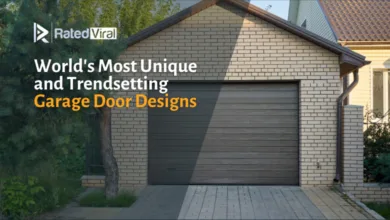Easy DIY Fixes for Garage Door Repair
An unreliable garage door can disturb the smooth rhythm of a person’s day and cause unforeseen inconveniences. These may vary from being unable to get to your car or truck to compromising the safety of your home; nevertheless, it is amazing how many common problems there are with garage doors that are easily fixed within minutes. Time, money, and worry can all be saved by recognizing these issues and learning how to deal with them.
This article is meant for people who need quick fixes for frequently malfunctioning garage doors but do not want to hire professionals. With a couple of simple Do-It-Yourself (DIY) techniques for troubleshooting and repair advice, anyone can return his or her gate to its correct operational mode. This manual will provide you with specific step-by-step instructions and general knowledge of what happens when some typical things go wrong, like doors not opening or closing properly, strange sounds coming out during operation, sensor failure, etc. You can confidently tackle any of these problems after going through this guide.
Common Garage Door Problems & How To Fix Them With DIY
Garage doors occasionally act up – they squeak, refuse to open, or get stuck. Doing some handy work might be all needed to save the day and a few dollars too.
Broken Springs
According to experts from garage door repair Langley, One of the main parts needing garage door maintenance is the springs. People usually face this problem when their garage door doesn’t work anymore.There are mostly two types of springs – torsion (usually arranged in parallel above the door) and extension (mounted along the horizontal tracks). Both of them have different qualities, such as length or weight-bearing capacity, but serve one purpose: balancing the weight of the erected structure (door leaf + electric opener). This is why it’s important to understand how they function so that repairs can be made whenever necessary.
Torsion Spring
Although there are many ways to install torsion springs (and many places that sell them), this section will only cover the basic principles. Every single component has an important role and should not be neglected or underestimated. However, winding up them is quite dangerous due to the great amount of stored energy. That’s why this task should be performed only by professionals who have the necessary instruments and skills.
The typical signs of a damaged/old garage door torsion spring include visible rust or peculiar sounds while opening/closing the equipment. Additionally, sometimes the wires get loose or even break, which greatly contributes to the overall condition of the mentioned part.
Extension Spring
This type of spring expands and contracts. When the garage door closes, the springs contract to provide lifting force. Conversely, when opening it, they release it to create tension. Since they are attached to cables that hold most of the weight of a big metallic panel, their frequent utilization may lead to fraying or breaking these strands. As a result, the whole system can be damaged. That’s why sometimes people notice that their doors have become heavier than before, although nothing has happened recently concerning this matter
Openers Not Working Properly
Garage doors always seem to malfunction when you least expect it. What’s the usual suspect? Faulty openers. How to fix them is the subject of some simple do-it-yourself (DIY) troubleshooting tips for garage door openers.
- Check the power supply: Ensure the opener is plugged in and the circuit breaker has not been tripped.
- Change the remote control batteries: Your keypad might need new ones too.
- Clean and adjust sensors: A dirty or misaligned sensor can cause the door to stop closing. Wipe them off with a cloth, and then point each other again.
- Reset it by unplugging it for 1 minute, then plugging it back into its outlet.
- Manually operate it: Pull the release handle (usually red) to disconnect the opener from the door and try moving.
- Look at whether anything obstructs the tracks of your doors, such as leaves, toys, etc.
- Tighten loose hardware such as nuts and screws that may become loose over the years due to vibrations of doors while operating them.
- To help rollers move easily during opening and closing, apply silicone spray or engine oil to hinges, bearings (if any), and all movable parts connected to the garage door.
- If force settings adjustment is needed, consult the owner manual on how this should be performed for a particular model used at home because different openers have different force settings adjustment procedures, as described in their manuals or the instructions attached.
- For proper functioning, metal tracks should always be straight, so if they get bent out of shape, use a rubber hammer to align them back into position. If damage cannot be reversed, replace them altogether.
Damaged Panels
Damaged garage door panels can make a home look really bad. But you don’t have to fix this problem immediately or get a professional involved.
- First, determine how severe the damage is. Sometimes, you can care for it yourself if it’s a scratch or a small dent.
- For wooden doors, some wood filler can do wonders. Apply it gently, then sand off excess when dry.
- Metal doors require different tactics. Try using a plunger to push out dents.
- Occasionally, paint might cover little scratches so they disappear entirely.
- Patching kits sold at most hardware stores come in handy where there are cracks.
- Always clean the patching area before starting any repairs – dirt or debris will ruin everything.
- If the panel pieces have broken off entirely, attach them back with a strong outdoor adhesive.
- Ensure that the new paint matches the old one as closely as possible for a seamless finish.
Preventative Garage Door Problem Tips
Keeping your garage door happy is not hard—it just takes some love and care. Doing little things now saves big headaches later.
Don’t forget about the garage door in your regular home maintenance routine. Keep these items checked off every once in a while to ensure that everything is running smoothly:
- Check if any hardware is loose; doors and tracks can go out of alignment from all that opening and closing.
- Keep those moving parts happy with yearly oil love—think rollers, hinges, and springs.
- Rollers should be given a thorough look-see twice annually; throw out anything worn or chipped.
- Inspect cables for fraying or signs of wear, but leave cable work to the pros.
- Replace the weather stripping at the bottom when it begins to look tired.
- Wipe down tracks using a cloth so dirt and debris don’t hinder a smooth ride for your door.
- Hardware should be tightened occasionally because every open-and-close shakes things up a little.
- Check the door balance by disconnecting the opener and lifting it halfway; if everything is okay, it should stay put.
- Look over safety features like auto-reverse—make sure they work by testing them with something solid like wood.
Proper Lubrication
Keeping your garage door running smoothly comes down to putting more oil on it. The right type of lubrication will ensure that the larger moving parts glide quietly past each other without sticking together or making much noise.
You don’t need expensive lubricants or special tools for this job; you only need silicone spray and lithium grease. Apply a thin layer of these products to all points where metal meets metal—the hinges, rollers, tracks, and springs.
Remember that less is more when it comes to greasing your garage door – excess oil will only attract more dust and grime, worsening the situation.
Weatherproofing
Professionals recommend that one should always protect their garage doors from being adversely affected by the elements. You can do this by fitting weather strips that seal off any gaps that may let in rainwater or snow. They also deter insects from invading your space. Replacing worn-out seals with new ones is equally effective in achieving the same objective.
Sealing stops cold air from entering, while insulation kits warm garages, especially in areas where temperatures drop significantly lower than others during winter. The units further reduce energy costs, saving individuals money while maintaining their storerooms well throughout these periods.
When should you call a professional for garage door repairs?
Sometimes, certain malfunctions with automatic gateways cannot be fixed using household tools alone. For instance, if it fails to open or close properly, makes unusual sounds, or feels shaky, it might require intervention beyond what an amateur can offer. These signs indicate potential hazards that demand immediate attention from experts with the necessary skills and equipment for safe operation.
Professionals should handle tasks such as replacing broken springs or cables and installing new gates since they know how best to execute them without causing harm to themselves or others around them due to a lack of expertise in this area. It is, therefore, advisable not to attempt any repair related to these components unless trained professionally because failure to do so may lead to unwanted accidents.
In conclusion, Fixing garage door issues doesn’t have to be a headache. With the right tools and patience, anyone can tackle common problems like broken springs or wonky sensors in their garage.
These easy DIY fixes save money and give folks much satisfaction from doing it themselves. So next time the garage door acts up, don’t rush to call in the pros—grab that toolbox and get to work. You might just surprise yourself with how handy you can be.





